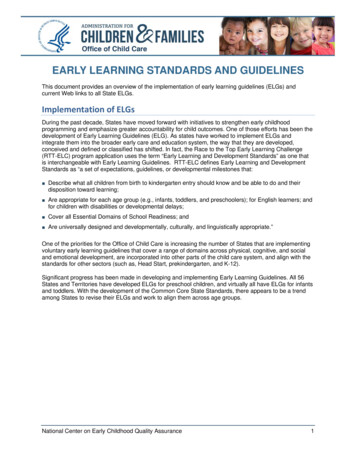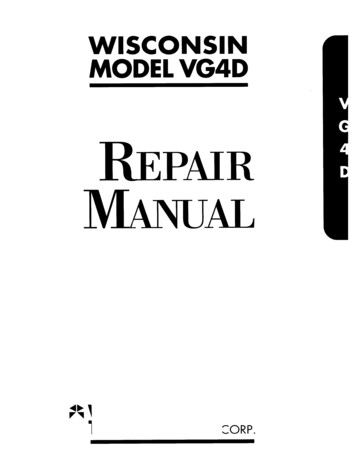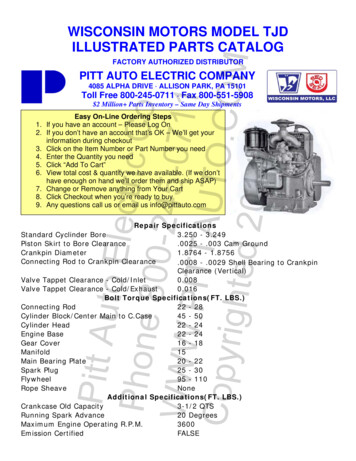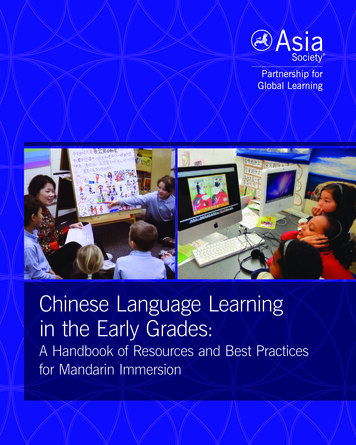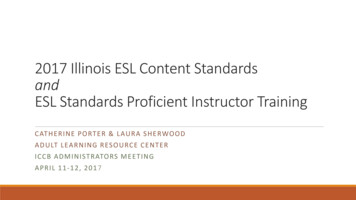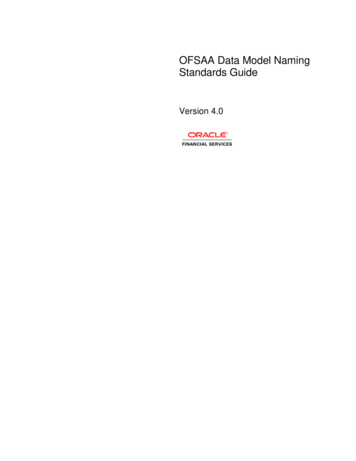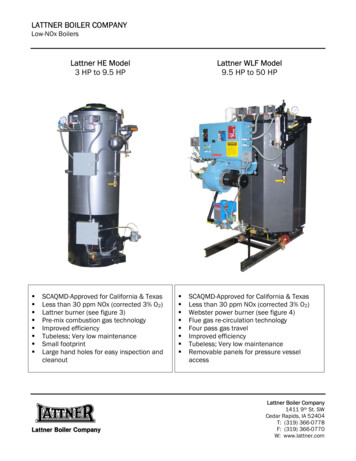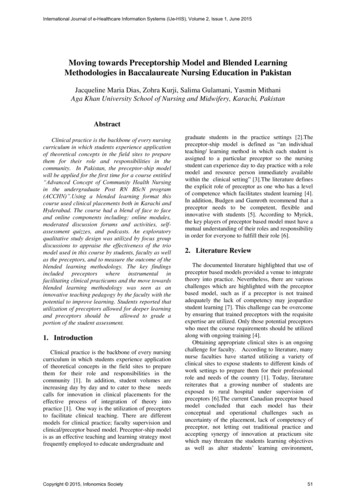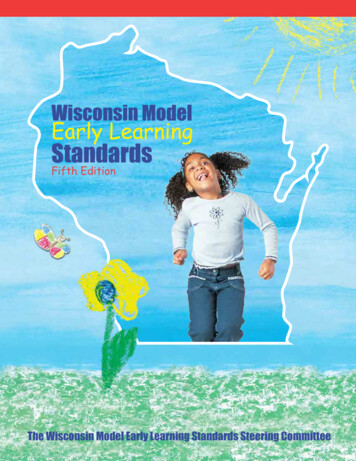
Transcription
Wisconsin ModelEarly LearningStandardsFifth EditionThe Wisconsin Model Early Learning Standards Steering Committee
WISCONSIN MODEL EARLY LEARNING STANDARDSWITH INTRODUCTION2003 Edition2008 Edition2011 Edition2013 Edition2017 Edition (Updates to the 2013 Edition)The Wisconsin Model Early Learning Standards Steering CommitteeWisconsin Department of Public InstructionWisconsin Department of Children and FamiliesWisconsin Department of Health ServicesWisconsin Head Start State Collaboration OfficeWisconsin Early Childhood Collaborating PartnersWisconsin Early Childhood AssociationWisconsin Division of Exceptional ChildrenFunding for the 2003, 2008, 2011, 2013, and 2017 Editions are from:Wisconsin Head Start State Collaboration ProjectWisconsin Department of Public InstructionWisconsin Department of Health ServicesBraided Funding InitiativeWisconsin Early Childhood Collaborating PartnersGreat Lakes Head Start Quality Network (QNet)Wisconsin Department of Children and FamiliesRace to the Top- Early Learning Challenge GrantWISCONSIN MODEL EARLY LEARNING STANDARDSi
This publication is available fromWisconsin Child Care Information Center2109 South Stoughton RoadMadison, WI 53716608-224-5388 or 1-800-362-7353Or order online at dcf.wisconsin.gov/ccic/wmelsThe Wisconsin Model Early Learning Standards (WMELS) are published in English, Spanish, and Hmong.All versions are available on the Wisconsin Early Childhood Collaborating Partners (WECCP) web page and canbe downloaded in a PDF format: www.collaboratingpartners.com/wmels-documents.php. This website alsohas related documents including: frequently asked questions, training materials, training calendars, alignmentwith Wisconsin Academic Standards, as well as information about curriculum and assessment.For more information on theWisconsin Model Early Learning Standards initiative contact:Katherine McGurkWisconsin Department of Children and ry W. KimballWisconsin Department of Public tober 2017Wisconsin Department of Public InstructionTony Evers, PhD, State SuperintendentISBN 978-1-57337-166-7The Wisconsin Department of Public Instruction does not discriminate on the basis of sex, race, color,religion, creed, age, national origin, ancestry, pregnancy, marital status or parental status, sexualorientation, or disability.Printed on Recycled PaperiiWISCONSIN MODEL EARLY LEARNING STANDARDS
AcknowledgementsWMELS State and Regional Steering Committee, 2013& 2017 Leadership TeamAnn Ramminger, Southern Region Community CollaborationCoach; Early Childhood Professional Dev., UW Waisman CenterVikki Lane Kunstman, Retired, Curriculum and InstructionCoordinator and Early Learning Consultant, CESA 6The following people advised on the 2003 and/or2008/2011/2013/2017 editions of the standardsBarbara Chaney, UW-LaCrosseYa-Fang Cheng, UW-MadisonChristine Enockson, Watertown Unified School DistrictBeth Graue, UW-MadisonKathy Hartjes, Wisconsin Kindergarten TeachersAssociationSally Jansen, Green Bay Public Schools Head StartPatricia Kielpinski, Milwaukee Area Technical CollegeSherry W. Kimball, Waisman Center, UW-MadisonJoan Laurion, UW-Extension – Dane County and FamilyChild CareJulie Lennon, Green Bay Public Schools Early Childhood SpecialEducationMary McLean, Ph.D., UW-MilwaukeeLana Nenide, Wisconsin Alliance for Infant Mental HealthBarb Novak, Wisconsin Department of Public InstructionCasey O’Keefe, MS/CCC-SLP Cardinal Stritch UniversityElizabeth Olsen, CESA 5/ Dane County Parent CouncilTeressa Pellett, Children’s Trust FundMary L. Peters, Waisman Center, UW-MadisonPence Revington, Parents Plus Wisconsin (PIRC)Mary Roach, Ph.D., UW-ExtensionConnie Robers, Rock-Walworth CFS Head StartPaul Sandrock, Wisconsin Department of Public InstructionElaine Strom, Dane County Parent Council, Inc.Ann Terrell, Early Childhood Council and MilwaukeePublic SchoolsGaye Tylka, Early Childhood Response to Intervention StatewideCoordinator, CESA 4Paula Wainscott, Eau Claire Schools Head StartSheila Weihert, Heritage Elementary School, De PereChristopher Weinhold, Wisconsin Rapids Public SchoolsChristina Wen, Waisman Center, UW-MadisonResearch and Development2008/2011/2013 Editions Layout, Editing, Proofing, andCover DesignArlene Wright, WMELS Statewide Coordinator, Office of EarlyLearning, Wisconsin Department of Public Instruction (2013)Jill Haglund, Office of Early Learning, Wisconsin Department ofPublic InstructionJulie Betchkal, Early Childhood Program Support, CESA 11(2017)Wendy Bowe, Head Start Technical Assistance CenterAbbe Braun, Supporting Families Together AssociationAmy Carriere. Early Childhood Program Support, CESA 10 (2017)Glenna Carter, WI Child Care Information Center (2017)Penny Chase, Supporting Families Together Association (2013)Ruth Chvojicek, WI Birth-3 RESource (2017)Bridget Cullen, Division for Early Childhood Care and Education,Wisconsin Department of Children and FamiliesCatharine Daentl. WECCP Website Manager, CESA 5 (2017)Jenny Giles, Special Education Consultant, WisconsinDepartment of Public InstructionJill Hoiting, Supporting Families Together AssociationCarrie Holden, WECCP Regional Collaboration Coach-Milwaukee(2017)Heather Jordan, Great Lakes Inter-Tribal Council (2017)Sherry W. Kimball, UW Waisman Center (2017)Linda Leonhart, Head Start Collaboration Office, WisconsinDepartment of Public Instruction (2013)Kathy McGurk, Division for Early Childhood Care and Education,Wisconsin Department of Children and FamiliesJoanna Parker, Office of Early Learning, Wisconsin Department ofPublic InstructionJeanette Paulson, Wisconsin Early Childhood AssociationMary L. Peters, Waisman Center, UW MadisonMichelle Ogorek, Statewide Early Childhood Coordinator,Wisconsin Department of Public Instruction (2017)Nicole Lopez, The Registry, Wisconsin (2017)Ann Ramminger, Office of Early Learning, Wisconsin Departmentof Public InstructionWaisman Center, UW Madison(2013)Katie Roberts, Wisconsin Technical College SystemPamela Torres, Great Lakes Inter-Tribal Council (2013)The 2003 edition of the Wisconsin Model Early LearningStandards was researched and written by Diane Jenkins,Jenkins and Associates, Madison, Wisconsin.The 2008/2011/2013 edition of the Wisconsin Model EarlyLearning Standards was researched and written by thefollowing team:Arlene Wright, WMELS Coach and 2008/2013 Lead Coordinator;Independent Education Consultant, Chippewa FallsRuth Chvojicek, OSEP Outcome Grant Coordinator; EarlyEducation Program Support, CESA 5Linda Hurst, WMELS Coach; Early Childhood ConsultantWISCONSIN MODEL EARLY LEARNING STANDARDSOriginal Layout: Fernando Hernandez, CESA 5Original Editing and Layout: Neldine Nichols, WisconsinDepartment of Public InstructionRevision Editing: Arlene Wright and Laura Paella, WisconsinDepartment of Public Instruction; Glenna Carter, Child CareInformation CenterProofing: Roslyn Wise, WI Department of Public InstructionCover Design: Cynthia Hoffman Meldorf at MercuryCommunication in conjunction with the Think Big Start Small:Invest in a Child’s Future public awareness campaigniii
ivWISCONSIN MODEL EARLY LEARNING STANDARDS
Wisconsin Model Early Learning StandardsTable of ContentsAcknowledgements.iiiIntroduction.1I. Health and Physical Development.12A. Physical Health and Development.14B. Motor Development.20C. Sensory Organization.23II. Social and Emotional Development.26A. Emotional Development.28B. Self-concept.32C. Social Competence .35III. Language Development and Communication.42A. Listening and Understanding.44B. Speaking and Communicating.47C. Early Literacy .54IV. Approaches to Learning.66A. Curiosity, Engagement, and Persistence.68B. Creativity and Imagination.71C. Diversity in Learning.73V. Cognition and General Knowledge.78A. Exploration, Discovery, and Problem Solving.80B. Mathematical Thinking.85C. Scientific Thinking.96Interest Areas: Children Learn from Play.102AppendixesAppendix A: Alignment of Wisconsin Model Early Learning Standards withWisconsin Academic Standards for English Language Arts andMathematics and Wisconsin Essential Elements.107Appendix B: Wisconsin Model Early Learning Standards andIDEA Early Childhood Outcomes.114Appendix C: References and Resources.116Appendix D: Early Care and Education Resource Listing.124WISCONSIN MODEL EARLY LEARNING STANDARDSv
viWISCONSIN MODEL EARLY LEARNING STANDARDS
Wisconsin Model Early Learning StandardsIntroductionThe Wisconsin Model Early Learning Standards provide a common language andguidance for families, professionals, and policymakers around early childhoodeducation and care.Why do we have model early learning standards? Basedon research and supported by evidence-based practices,the Wisconsin Model Early Learning Standards (WMELS)provide a framework for families, professionals, andpolicymakers to:The basis for the development of the WMELS is a set ofguiding principles that specify beliefs and values aboutyoung children in Wisconsin. The primary principles areas follows: All children are capable and competent. Early relationships matter. A child’s early learning and development ismultidimensional. Expectations for children must be guided byknowledge of child growth and development. Children are individuals who develop at various rates. Children are members of cultural groups that sharedevelopmental patterns. Children exhibit a range of skills and competencieswithin any domain of development. Children learn through play and the active explorationof their environment. Parents are children’s primary and most importantcaregivers and educators.Share a common language and responsibility for thewell-being of children from birth to first grade; Know and understand developmental expectations ofyoung children; and Understand the connection among the foundations ofearly childhood, K-12 educational experiences, andlifelong learning.With the inclusion of the birth-to-3 age range, the revisedWMELS also includes developmental continuums,sample behaviors of children, and sample strategies foradults.The development of the standards was guided byresearch in the field and supported by content expertsfrom institutions of higher education in the state. Alignedto the Wisconsin Academic Standards (kindergartenthrough grade 12), the WMELS are intended to provideearly learning opportunities that support children’scontinued success in school and future life.WISCONSIN MODEL EARLY LEARNING STANDARDSA more detailed description of the WMELS GuidingPrinciples is located on page 10 of the Introduction Section.1
Wisconsin Model Early Learning StandardsFrameworkThe Wisconsin Model Early Learning Standards specify developmental expectations forchildren from birth through entrance to first grade. The Wisconsin Model Early LearningStandards reflect attention to all the domains of a child’s learning and development.Each domain is divided into sub-domains. Each sub-domain includes developmentalexpectations, program standards, performance standards, and developmental continuum.Samples of children’s behavior and adult strategies are also provided. The framework isdescribed below in a narrative and on the following page as a chart.Developmental DomainsDiscrete area of the child’s development. The areas areinterrelated and include: Health and Physical DevelopmentCurriculum and Assessment Language Development and CommunicationEach program/service can determine their own curriculumand assessment based on the standards and local age/grade level expectations that apply to their particularsetting. Selection of curriculum and assessment is a localdecision.
Heather Jordan, Great Lakes Inter-Tribal Council (2017) Sherry W. Kimball, UW Waisman Center (2017) Linda Leonhart, Head Start Collaboration Office, Wisconsin Department of Public Instruction (2013) Kathy McGurk, Division for Early Childhood Care and Education, Wisconsin Department of Children and
